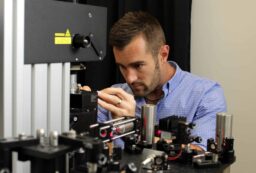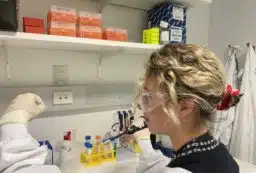Australian orchids are engaged in an arms race, using sensory overload to seduce male insects.
Macquarie University PhD student Anne Gaskett has discovered just how they do it. Her work is important to the conservation of orchids and the control of economically important agricultural pests.
Gaskett has been analysing the smells, colours and shapes of flowers from an insect’s perspective.
She has found that orchids mimic female insects so well that male insects cannot resist mating with them, accidentally collecting the pollen.
“I have accumulated the first compelling evidence of an ongoing and escalating arms race between orchids and their unwitting insect pollinators,” Gaskett, says, “Over generations the insects learn to avoid having sex with orchids, and this means only the most persuasive orchids reproduce, which drives the acceleration of orchid subterfuge.”
The Australian bush is rife with such sexual deception, Gaskett says, as native orchids lure pollinators with false promises of romance.
Gaskett has been studying the hardworking Orchid Dupe wasp (Lissopimpla excelsa), which is fooled into copulating with not just one, but five native Tongue Orchid species (Cryptostylis) in urban and regional Australia.
All the Tongue Orchid species mimic the female Orchid Dupe wasp. But, to the human eye, they look quite different.
By using modern technology to study the physics of the colours of the orchids and the female insects, Gaskett has revealed that they are identical when viewed by male insects. The flowers are also shaped to mimic female insect bodies.
Gaskett is now looking at the impact of the chemical components of orchid perfumes directly on wasp antennae, to understand what makes these fragrances irresistible.
Studying these intimate interactions addresses big questions about nature and evolution and highlights the millions of other unknown interactions crucial for a sustainable and healthy environment.
“These insects might be fools for love, but their role as orchid pollinators makes them indispensable.”
Anne Gaskett is one of 16 early-career scientists presenting their research to the public for the first time thanks to Fresh Science, a national program sponsored by the Federal and Victorian Governments.





 Fresh Science is on hold for 2022. We will be back in 2023.
Fresh Science is on hold for 2022. We will be back in 2023.